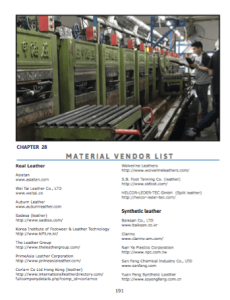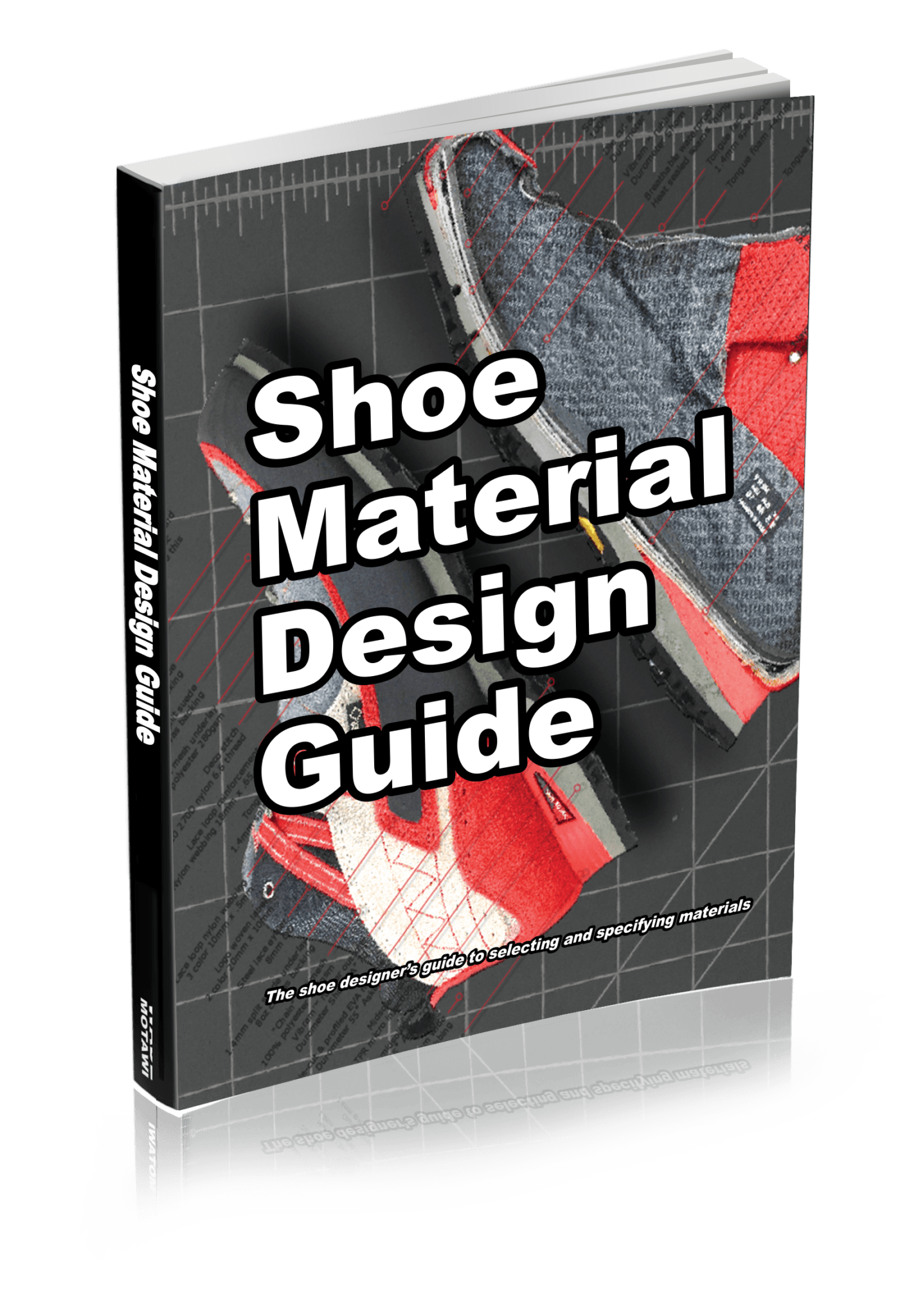The Shoe Material Design Guide – Our newest book!!
Do you want to be a professional shoe designer? You must learn how to select and specify each shoe material correctly. Our newest book, The Shoe Material Design Guide, details all the shoe materials you will need to make modern athletic, classic casuals, and high fashion footwear. You will learn about all the materials used to make shoes.
Each chapter covers a specific shoe material type. You will learn how each material is made, the options available, and how to specify the material correctly. We have chapters on shoe leather, textiles, synthetics, shoelaces, glue, reinforcements, hardware, logos, midsoles, outsoles, a complete shoe materials list and more!
 We have included annotated cross sections of over 30 different shoe types. You can see exactly how each shoe materials are used inside real production shoes. Look inside basketball shoes, running shoes, track spikes, hiking boots, work boots, high heels, cowboy boots and many more!
We have included annotated cross sections of over 30 different shoe types. You can see exactly how each shoe materials are used inside real production shoes. Look inside basketball shoes, running shoes, track spikes, hiking boots, work boots, high heels, cowboy boots and many more!
You will also find information on topics such as shoe material testing, sustainable production, exotic materials and more. Written as a companion to our best selling How Shoes Are Made, The Shoe Material Design Guide digs deep into the world of footwear materials and design. Softcover, 330 color photos, 28 chapters, 195 pages.
The Shoe Material Design Guide
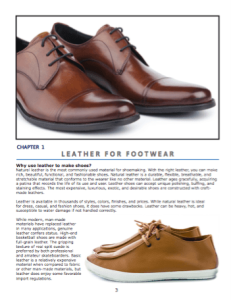 Chapter 1: Leather for footwear
Chapter 1: Leather for footwear
How leather is made and how to use leather in your shoe designs.
What materials are shoes made out of? Leather is the most commonly used material for shoemaking. It is durable, flexible, breathable, stretchable and conforms to the wearer like no other material. Study the character, color, grain, thickness, temper and the production steps such as curing, soaking, liming, tanning, etc. Next, we look at the finishing operations, final grading and main types of shoemaking leather like aniline, nubuck, pigmented, top-grain, crazy horse, split leathers, patent leather, action leather and many more. Finally, we cover leather import duty and tariffs, price per square foot and how to specify shoe leather.
The Ultimate Shoe Material Textbook
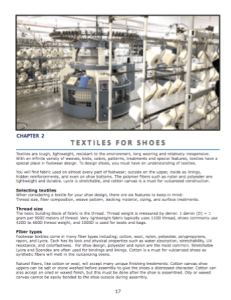
Chapter 2: Textiles for Shoes – Shoe Fabrics
Fabric options for footwear. Shoe material types and shoe fabrics such as textiles are tough, lightweight, resistant to the environment, long wearing, and relatively inexpensive. What is the best sneaker material or the best basketball shoe material? Review footwear fabrics such as nylon, polyester, Kevlar, linen, Rayon, wool and their processing, weaves, backing, treatments, and other special features. Study the environmental factors, import duty, lasting and test standards for textiles.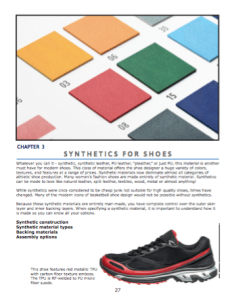
Chapter 3: Synthetics for shoes
Man-made materials for the modern shoe. Synthetic, synthetic leather, PU leather, pleather, or PU; whatever you call it, this class of shoemaking material offers an immense variety of colors, textures, and features at a range of prices. What are sports shoes and athletic shoes made of? What are basketball shoes made of? Synthetics! What is a synthetic upper? This shoe material can be made to look like natural leather, split leather, textiles, wood, metal or almost anything. Many of the modern icons of basketball shoe design would not be possible without synthetics. When specifying synthetics you have complete control over the outer skin layer and inner backing layers so it is important to understand how it is made and know all your shoemaking material options.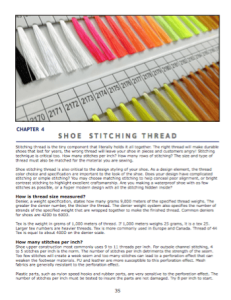
Chapter 4: Shoe Stitching Thread
Thread and stitching hold it all together. Shoe stitching thread is also an important shoe designing material. As a design element, the thread color choice and specification are important to the look of the shoe. You may choose matching stitching for your sneaker materials list to help conceal poor alignment, or bright contrast stitching to highlight exceptional craftsmanship and your shoe print fabric. Are you making a waterproof shoe with as few stitches as possible or a hyper-modern design with all the stitching hidden inside? Learn about this tiny component that holds it all together.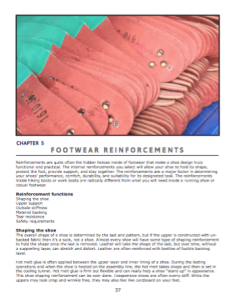
Chapter 5: Footwear Reinforcements
How to create, support, and fix the shape of shoes. The internal reinforcements you select will allow your shoe to hold its shape, protect the foot, provide support, and stay together. Reinforcements are a significant factor in your shoes’ performance, comfort, durability, and suitability for its designated task. Look at heel counters, heat-molded plastic sheets, vulcanized rubber, backing materials and outsole reinforcements.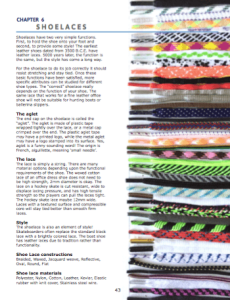
Chapter 6: Shoelaces
Options for shoe closure systems. Shoelaces hold the shoe onto your foot and provide some style. Study the construction, materials, lacing systems. The “correct” shoelace depends on the function of your shoe. The same lace that works for a fine leather office shoe will not be suitable for hunting boots or ballerina slippers.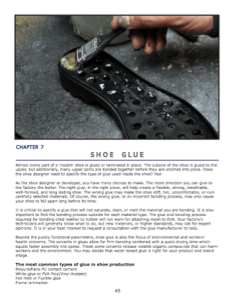
Chapter 7: Shoe glue
The use and application of adhesives in shoes. Almost every part of a modern shoe is glued or laminated in place. It is critical to specify a glue that will not saturate, stain, or melt the material you are bonding. It is also important to nd the bonding process suitable for each material type.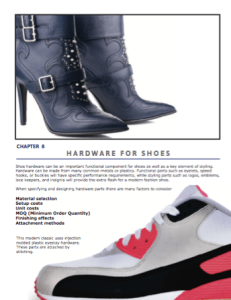
Chapter 8: Hardware for shoes
Metal and plastic parts for shoes. Functional parts such as eyelets, speed hooks, or buckles will have specific performance requirements. When specifying and designing hardware parts for your shoes, there are many factors to consider such as material selection, setup costs, unit costs, MOQ (Minimum Order Quantity), finishing effects, testing, and attachment methods.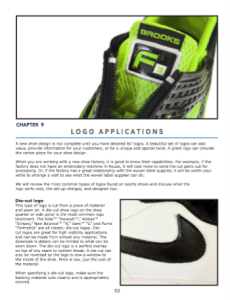
Chapter 9: Logo applications for shoes
Techniques for branding shoes. A new shoe design is not complete until you have detailed its logos. We will review the most common types of logos found on sports shoes like die cuts, screen printing, embossed, embroidery, woven labels, molded logos, PVC gel bubbles and discuss what the logo parts cost, the setup charges, and designer tips.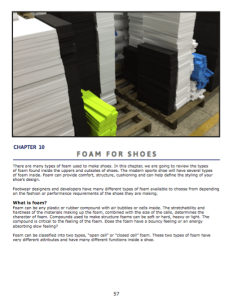
Chapter 10: Foam for shoes
How to specify foam. What is foam? The modern sports shoe will have several types of foam inside. It is important to know what foam is appropriate for the shoe upper and what is appropriate for cushioning the shoe outsole. When specifying foam, it is critical to understand the performance attributes such as density, durometer, compression set, impact resistance, energy return conformability, breathability, and more.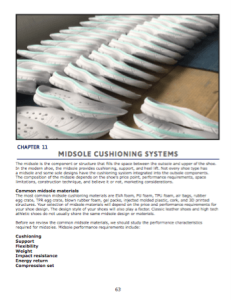
Chapter 11: Midsole cushioning systems
A review of 14 different midsole types. The midsole provides cushioning support, and heel lift. Not every shoe type has a midsole, and some sole designs have the cushioning system integrated into the outsole components. We cover various types such as Cup, cut, and buff sole, injection molded EVA, airbags, and Polyurethane foam, advising the tooling cost and unit price for these and many more.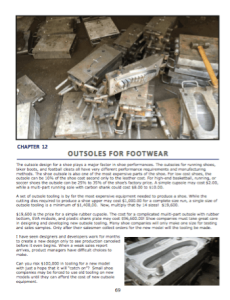
Chapter 12: Outsoles for footwear
A study of 8 different outsole constructions. The shoe outsole is one of the most expensive parts of the shoe and a set of outsole tooling is by far the most expensive equipment needed to produce a shoe. Rubber cupsoles, compression molded EVA soles, injection molded outsoles and 5 others are uncovered and analyzed.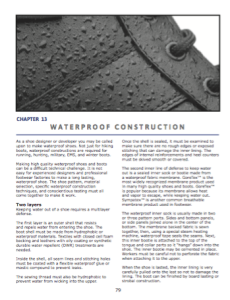
Chapter 13: Waterproof constructions
An overview of waterproof construction techniques. Making high-quality waterproof shoes and boots can be a difficult technical challenge. See inside a waterproof boot. The shoe pattern, material selection, specific waterproof construction techniques, and conscientious testing must all come together to make it work.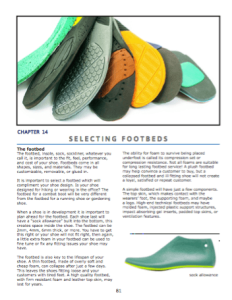
Chapter 14: Footbeds
Picking the right footbed, ten options to study. Footbeds come in all shapes, sizes, and materials. They may be customizable, removable, or glued in. It is important to select a footbed which will compliment your shoe design. Will it be molded or die cut? Multi-density, hybrid, or crystallized PU? What material will cover it, what other features will you need for your shoe?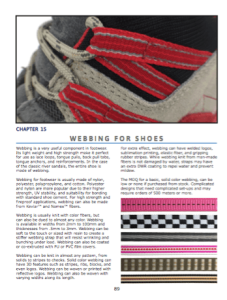
Chapter 15: Webbing For Shoes
Options and uses of webbing. Its light weight and high strength make webbing perfect for use as lace loops, tongue pulls, back pull tabs, tongue anchors, and reinforcements. Webbing for footwear is usually made of nylon, polyester, polypropylene, or cotton. It can be knit with colors or dyed and comes in various widths, thicknesses, and even 3D features such as ribs or logos.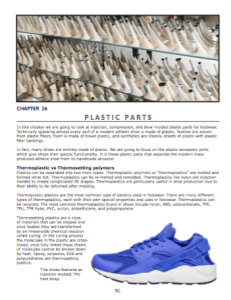
Chapter 16: Plastic parts
A quick study of plastic molding for shoe parts. Almost every part of a modern athletic shoe is made of plastic, we will look at injection, compression, and blow molded plastic parts for footwear. Technically speaking, textiles are woven from plastic fibers, foam is made of blown plastic, and synthetics are actually sheets of plastic with plastic fiber backings. We are going to focus on the plastic accessory parts which give shoes their special functionality.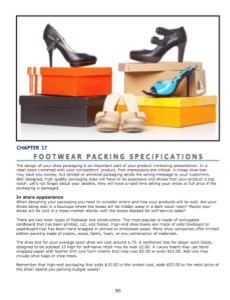
Chapter 17: Footwear Packing Specifications
How to design and specify packing materials for shoes. Shoe packaging is a significant part of your product marketing presentation. It is also important to consider where and how your products will be sold. The shoe box for your average sports shoe may cost anywhere from $0.75 to $10 for high-end packaging. Learn how the corrugated board is specified by the weight of the skin papers and the size of the flute pattern and get the details on inner box vs. case box, graphics effects, die lines, etc.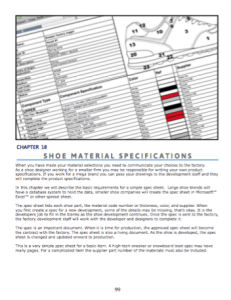
Chapter 18: Shoe material specifications
How to create a footwear specification. A detailed specification sheet is absolutely critical to your success. We will describe the requirements for your specification sheet, material maps, header details, how to specify the outsole unit and we will show you samples. The best materials used in basketball shoes.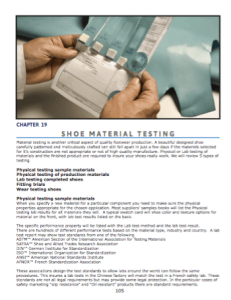
Chapter 19: Shoe material testing
Testing requirements for shoes and shoe materials. Physical testing and lab testing of materials and the finished product are required to ensure your shoes work. We will review five types of testing including tests for waterproof shoes and bonding trials. How is a waterproof shoe made? Shoe designing materials and shoe fabric review.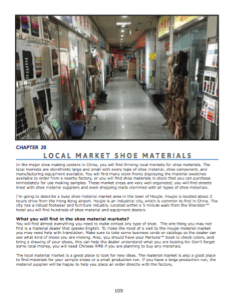
Chapter 20: Local market shoe materials
Using locally available stock materials. Local markets are storefronts large and small with every type of shoe material, shoe component, and manufacturing equipment available to buy. What will you find and how can you get the most out of your visit? Also, you must be careful when purchasing shoe materials from the local market. The supply factory’s contact information may not always be available, and there may not be material physical test data reports ready.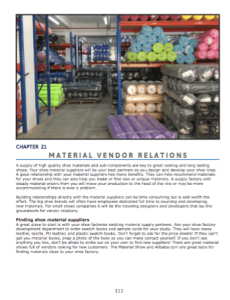
Chapter 21: Material vendor relations
How to get the most from your material vendors. Your shoe material suppliers can be your best partners as you design and develop your shoe lines. How to find suppliers, develop materials, and what it means to nominate a supplier. Shoe material vendors and shoe material suppliers uncovered.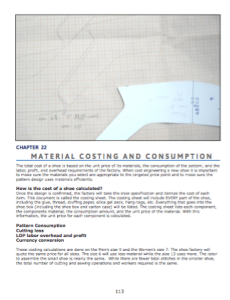
Chapter 22: Material costing and consumption
How to calculate the cost of shoe components. Pattern consumption, cutting loss, labor, overhead, and profit and currency conversion are all important factors which make up the cost of a shoe. See our infographic on the cost breakdown of the materials and a sample costing sheet. What are women’s shoes made of? See what sneakers are made out of? What are men’s shoes made of? We’ll break down the costs.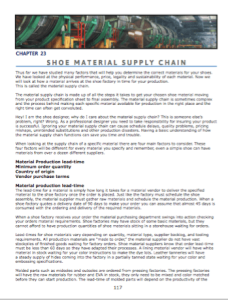
Chapter 23: Shoe material supply chain
The challenges of sourcing footwear materials. When looking at the supply chain for a specific material, there are four main factors to consider which include the country of origin and the vendor purchase terms. These factors along with others will be different for every material you specify. What are the materials used to make shoes? Shoe fabrics, shoe leather, synthetic mesh, what materials are basketball shoes made of, and more. Remember, even a simple shoe can have materials from over a dozen different shoe material suppliers.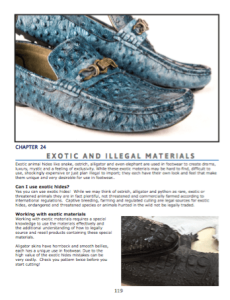
Chapter 24: Exotic and illegal materials
How to know if rare materials are safe and legal to use. Exotic animal hides like snake, ostrich, alligator, and even elephant are used in footwear to create drama, luxury, mystique and a feeling of exclusivity. What do they cost and how do you work with them?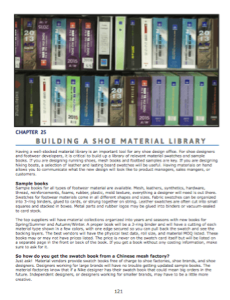
Chapter 25: Building a shoe material library
Tips and techniques for collecting material swatch books. It is critical to build a library of relevant material swatches and sample books. Having materials on hand allows you to communicate what the new design will look like to product managers, sales managers, or customers. How to get the most from shoe material vendors, shoe material suppliers, and shoe material manufacturers.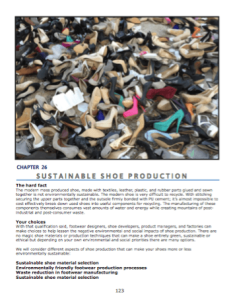
Chapter 26: Sustainable shoe production
How to reduce the environmental impact of your shoes. Footwear designers, shoe developers, product managers, and factories can make choices to help reduce the negative environmental and social impacts of shoe production. We will consider different aspects of shoe production that can make your shoes more or less environmentally sustainable.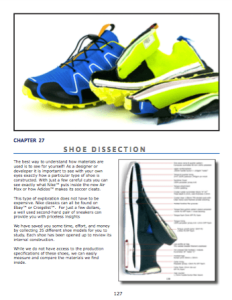
Chapter 27: Shoe dissections
Cross section views of popular shoe styles. The best way to understand how materials are used is to see for yourself! We have saved you some time, effort, and money by collecting 35 different shoe models for you to study. Each shoe has been photographed, opened up, and labeled to expose and review its internal construction. See what Nike Shoes are made out of, what Vans shoes are made out of, what women’s shoes are made out of, how a running shoe is made, what are the best materials for shoes, what hiking boots are made out of, how a basketball shoe is made and more. You’re going to love this!